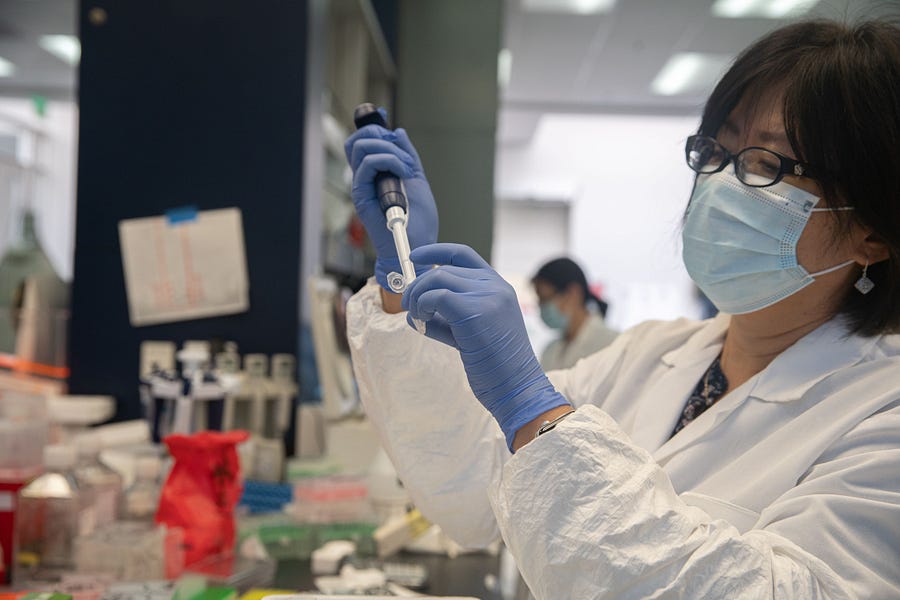These days, our national conversation about the coronavirus pandemic tends to revolve around speed. Can we get vaccines into people’s arms fast enough to stop the disease in its tracks? Or will new and worse variants of the virus outsprint our efforts, forcing us to hustle again to develop variant vaccines as well? For those who care for the virus-stricken, however, the work is a long, slow marathon, not a sprint.
The early days of the pandemic were a time of furious experimentation and innovation, as doctors scrambled to discern what combination of existing drugs and treatments would give people struggling against this formidable new virus their best shot at survival.
By summer, they had built out their toolkit. The antiviral remdesivir, to inhibit the virus’s ability to replicate. Anti-inflammatory drugs like dexamethasone, to prevent a dangerous immune overreaction to the disease. Anticoagulants to fight its tendency to clot the blood. Placing struggling patients on their stomachs to make breathing easier—a technique known as “proning”—and not intubating them on ventilators except as a last resort. Despite the dire circumstances, these practices helped blunt the edge of the deadly pandemic, undoubtedly saving many lives.
Yet all these measures are only ameliorative; COVID-19 remains a disease without a cure. As the pandemic has dragged on, care for the sickest patients has remained in this gear: Doctors use the treatments that help and pray for the best.
“Treating a virus is so difficult,” said Dr. Megan Ranney, a professor and emergency doctor at Brown University. “You look at herpes, HIV, flu, respiratory syncytial virus—for many of them, we have treatments that maybe mitigate the effect of the virus for a short period of time, but don’t eliminate it and aren’t fully effective. We may get lucky, but we know with viruses in general, for the vast majority of viruses that are out there, the best strategy is prevention.”
If anything, data accumulated since the summer has only underscored how difficult it is to help patients once the disease has progressed to the point of critical care.
“Remdesivir we continue to use, but as data has accumulated it’s become less and less impressive as a treatment. It was thought of as this thing, can we rush to give it to people early on,” Dr. Ranney said. “And now, we’ll give it, but we don’t expect a miracle. The anticoagulants, which we were very, very hopeful were going to transform care and prevent blood clots, have not panned out to the degree that we’d hoped. This is the story of medicine and particularly bad viruses, that viruses are really tough to treat, and their consequences are really tough to prevent and treat.”
There has been one significant development in COVID treatment since last summer: the arrival of monoclonal antibody therapies, injections of synthetic proteins that function as antibodies, holding the line against the virus until the immune system catches on and sends in reinforcements. Donald Trump famously received a dose of Regeneron’s antibody drug when he was hospitalized with COVID last October, crediting it for his quick recovery and promising it would be available to the public very soon.
“They gave me Regeneron, and it was like unbelievable. I felt good immediately,” he said in a video recorded from the White House shortly after his return from the hospital. “We’ve authorized it. … We have hundreds of thousands of doses that are just about ready.”
The federal government has already committed to purchasing nearly a million doses of Eli Lilly’s antibody treatment and 1.5 million of Regeneron’s. But despite promising results, far fewer doses have actually been administered: Fewer than 130,000 of the Regeneron treatment as of last month, according to federal data.
The primary issue is logistical. Because the function of monoclonal antibodies is to jump-start the immune system, they’re most potent when administered as early as possible in a person’s illness. But COVID tends to be a slow-burn disease; a person might be sick for days or even weeks before things get bad enough for hospitalization, by which point the ship has likely sailed for antibody therapy. This means the ideal use case is for people in high-risk groups to take it when they’re first diagnosed—which in turn multiplies the number of doses required to take a bite out of the pandemic, because treatments can’t be targeted toward the sickest patients.
This characteristic of the drug has also led perversely to issues with demand: A person who takes monoclonal antibodies is significantly less likely to become seriously sick, but the treatment isn’t bringing very ill people back from the brink. Given that the severity of COVID cases varies wildly and inexplicably even among vulnerable populations, this makes it hard for people who received the treatment to know whether it was Regeneron that came through for them or simple luck, robbing the drug of the sort of testimonials (the former president’s notwithstanding) that can juice a drug’s demand. This fact, coupled with the relatively low supply still available, might help explain why monoclonal antibodies haven’t broken through as the baseline COVID treatment.
Other medicines and potential therapies remain in the pipeline, of course. Some doctors who spoke to The Dispatch spoke hopefully about nasal spray drugs that make it more difficult for viruses to get to your lungs in the first place. A number of antiviral and anti-inflammatory drugs specifically designed to target COVID are currently in late-stage trials, notably at pharma giant Merck, which recently dropped out of the vaccine race to concentrate its efforts on treatments.
And that’s not to mention the remarkable amount of ground-level research that has been sparked by the desperate times of our global pandemic. One recent study at the University of Nottingham, for example, found promising data for a drug called thapsogargin that might eventually form the basis for a new sort of broad-spectrum antiviral that could be effective against multiple types of virus and be taken by pill rather than injection. But the study’s authors told The Dispatch that this sort of information likely wouldn’t come into play until the next major pandemic.
In the meantime, the doctors caring for the sickest among us are soldiering on the best they can with what they have.
“My generation of doctors, we’re used to treating infectious disease,” said Dr. Akino Yamashita, who practices at a hospital in New York. “I think that COVID was the first time that I personally had to deal with basically a disease where I know that some of these patients are going to die no matter what I do. Which I think for most doctors is kind of morale-sapping.”






Please note that we at The Dispatch hold ourselves, our work, and our commenters to a higher standard than other places on the internet. We welcome comments that foster genuine debate or discussion—including comments critical of us or our work—but responses that include ad hominem attacks on fellow Dispatch members or are intended to stoke fear and anger may be moderated.
With your membership, you only have the ability to comment on The Morning Dispatch articles. Consider upgrading to join the conversation everywhere.